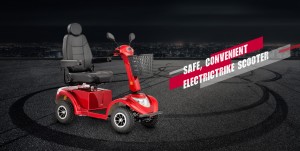3 Wheel vs 4 Wheel Mobility Scooters: A Complete Guide
Introduction
When it comes to choosing a mobility scooter, one of the most common questions is whether to opt for a 3-wheel or a 4-wheel model. Both types have their unique advantages and disadvantages, making them suitable for different environments and user needs. In this comprehensive guide, we will delve into the key differences between 3-wheel and 4-wheel mobility scooters, helping you make an informed decision.
3-Wheel Mobility Scooters
Design and Features
Three-wheel mobility scooters are designed with two rear wheels and one front wheel. This triangular design offers several unique benefits:
Maneuverability: 3-wheel scooters have a smaller turning radius, making them highly agile in tight spaces. This is particularly useful for indoor navigation, such as in shops, restaurants, and museums.
Legroom: The absence of a front axle means more legroom, which is beneficial for taller individuals or those with leg and knee issues.
Advantages
Superior Maneuverability: The tighter turning radius of 3-wheel scooters makes them ideal for navigating narrow corridors and crowded areas.
Increased Legroom: The design provides more space for the legs, enhancing comfort during long rides.
Lighter and More Portable: Generally, 3-wheel scooters are lighter and more compact, making them easier to transport and store.
Disadvantages
Less Stability: The triangular design makes 3-wheel scooters less stable, especially on uneven terrain or when taking corners at high speeds.
Limited to Smooth Surfaces: These scooters are best suited for indoor use or smooth outdoor surfaces like pavement.
4-Wheel Mobility Scooters
Design and Features
Four-wheel mobility scooters feature two rear wheels and two front wheels, providing a more stable platform:
Stability: The rectangular base with wheels at each corner offers better balance and stability, making them suitable for outdoor use.
Terrain Versatility: 4-wheel scooters can handle a variety of terrains, including cobblestones, grass, and hills.
Advantages
Enhanced Stability: The four-point design provides better balance, making these scooters safer for users with balance issues or those who need to navigate uneven surfaces.
Outdoor Capability: 4-wheel scooters are more versatile and can handle rougher outdoor terrains, making them ideal for extended outdoor use.
Higher Speeds and Greater Mileage: These scooters are built for frequent and heavy use, offering higher speeds and longer battery life.
Disadvantages
Less Maneuverability: The larger size and turning radius of 4-wheel scooters make them less agile in tight indoor spaces.
Heavier: The additional wheel and often higher weight capacity make 4-wheel scooters heavier and less portable.
Choosing the Right Scooter
Usage Considerations
Indoor Use: If your primary use case is indoor navigation, a 3-wheel scooter might be more suitable due to its superior maneuverability and increased legroom.
Outdoor Use: For outdoor activities, especially on uneven terrain, a 4-wheel scooter offers greater stability and versatility.
Personal Needs
Legroom: If you require more legroom, a 3-wheel scooter is the better choice.
Stability: If balance and stability are your primary concerns, a 4-wheel scooter is recommended.
Testing and Trying
Before making a decision, it’s advisable to test drive different models. Many dealers offer home assessments and test drives to help you find the perfect fit.
Conclusion
The choice between a 3-wheel and a 4-wheel mobility scooter largely depends on your specific needs and intended use. If you prioritize maneuverability and legroom, a 3-wheel scooter is ideal. However, if stability and outdoor capability are more important, a 4-wheel scooter is the way to go. By considering these factors and testing different model
Post time: Aug-04-2025



